Street lamps for a summer residence
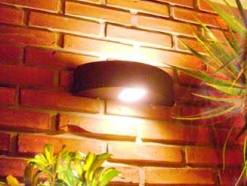 Properly designed lighting can dramatically change and transform street space at night. At the same time, the presence of lighting in the yard in the country or in a country house is necessary not only for beauty, but also to ensure safety, and also, to some extent, such lighting serves as a home guard. In this article, we will figure out what kind of street lights there are for a summer house and a country house, how to choose the right one and what is the best way to use it.
Properly designed lighting can dramatically change and transform street space at night. At the same time, the presence of lighting in the yard in the country or in a country house is necessary not only for beauty, but also to ensure safety, and also, to some extent, such lighting serves as a home guard. In this article, we will figure out what kind of street lights there are for a summer house and a country house, how to choose the right one and what is the best way to use it.
Today on sale there is a huge number of lamps to illuminate the yard and garden in the country or in a country house. It is very important not to get confused when choosing street lights, since the final look of your site at night, the possibility of practical implementation of everything planned, the final cost of the entire street lighting system, as well as the further operation of this entire farm, depend on what is chosen.
What are electrical circuits for and what types are they
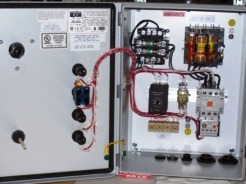 There are several different types of electrical circuits and any competent electrician must be sure to understand why they are needed, how they differ from each other, what information they contain, what conventions are used on different circuits, how to read them correctly.
There are several different types of electrical circuits and any competent electrician must be sure to understand why they are needed, how they differ from each other, what information they contain, what conventions are used on different circuits, how to read them correctly.
Very often people confuse the terms “types” and “types” of schemes. By type of circuit, they are divided into electric, pneumatic, hydraulic and combined. Combined circuits are most common in projects of automation of various technological processes, when in projects together with various electric motors, devices, sensors, elements of pneumatic automation and hydraulics are simultaneously used. Such schemes are called combined electro-pneumatic, electro-pneumatic or electro-hydraulic. By type, all electrical circuits are divided into ...
Koreans have created a flexible battery
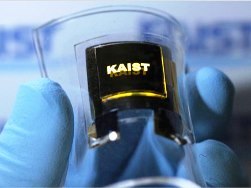 Korean experts have made an ultra-thin flexible battery. This invention in the near future may lead to the emergence of "folding" devices with a large display that can be folded and put in your pocket, or, for example, to the appearance of "television" wallpaper with a touch screen.
Korean experts have made an ultra-thin flexible battery. This invention in the near future may lead to the emergence of "folding" devices with a large display that can be folded and put in your pocket, or, for example, to the appearance of "television" wallpaper with a touch screen.
It’s no secret that the relatively inconvenient use of portable electronics is the relatively small display size. In the final analysis, there is always a rational size limit: the device should be comfortable to carry. However, devices that can be rolled up into a tube are, of course, a completely different story. A couple of years have passed since the time when the tablets appeared. But since then, the portable electronics industry has not demonstrated anything fresh in principle, except for cosmetic configurations and capacity building. Maybe the latest revolution in the market will be ...
How to quickly remove insulation from a cable or wire
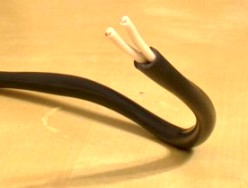 The figure shows a typical task. VVG cable 2 × 1.5mm2, consisting of two single-core conductors coated with insulation and placed in a black protective sheath. How to remove the sheath and insulation from the cable so that it is fast, safe, quality and reliable? Moreover, by quality I understand here the stability of the result.
The figure shows a typical task. VVG cable 2 × 1.5mm2, consisting of two single-core conductors coated with insulation and placed in a black protective sheath. How to remove the sheath and insulation from the cable so that it is fast, safe, quality and reliable? Moreover, by quality I understand here the stability of the result.
Of course, when it is possible to remove the insulation from the cable on the table, and not in a tight socket, and you need to make a couple of connections, everything can be done slowly, measured, checking every step. And if you need to make an apartment in front of plaster in a couple of days?
I tried three options for removing the insulation from the cable and stopped, as usual, on the third: stripping with a clerical knife, stripping with a special knife of the installer, stripping with a special device ...
Why Thomas Edison is considered the inventor of incandescent lamps
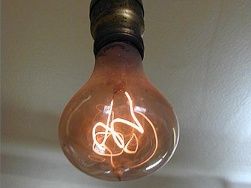 The history of incandescent lamps. In the second half of the 1870s, the idea of electric lighting using conductors heated by electric current was not new. Many scientists, engineers and inventors worked (conducted research and experiments) in this direction, because they clearly saw great prospects for the practical use of electric incandescent lamps. And it is not surprising, therefore, that in many countries there were inventors of the first incandescent lamp: in the UK - Svan, in Russia - Lodygin, in Germany - Goebel, in the USA - Edison. There were other names.
The history of incandescent lamps. In the second half of the 1870s, the idea of electric lighting using conductors heated by electric current was not new. Many scientists, engineers and inventors worked (conducted research and experiments) in this direction, because they clearly saw great prospects for the practical use of electric incandescent lamps. And it is not surprising, therefore, that in many countries there were inventors of the first incandescent lamp: in the UK - Svan, in Russia - Lodygin, in Germany - Goebel, in the USA - Edison. There were other names.
So why, then, in the public consciousness of almost all of mankind, there was a firm belief that it was Thomas Edison who invented the incandescent lamp? This is all the more surprising and incomprehensible, given that in America itself, already in the early 1880s, there were several inventors ...
 The first thing to do is prepare everything you need for soldering: a soldering iron, a small sponge, solder, pliers or tweezers, side cutters.
The first thing to do is prepare everything you need for soldering: a soldering iron, a small sponge, solder, pliers or tweezers, side cutters.
Plug the soldering iron into a power outlet and dampen the sponge with water. When the soldering iron heats up and begins to melt the solder, cover the soldering iron tip with solder, and then wipe it on a damp sponge. In this case, do not keep the sting in contact with the sponge for too long, so as not to overcool it. By wiping the sting against a sponge, you remove the remnants of the old solder from it. And in the process, to keep the soldering iron tip clean from time to time, wipe it with a sponge.
Before soldering, soldered areas need to be tinned or use already tinned parts. Manual soldering is probably hundreds or thousands, and since then, almost nothing has changed in technology, resin (rosin), it was then resin, and tin and lead also did not change. Soldering Training Technique ...
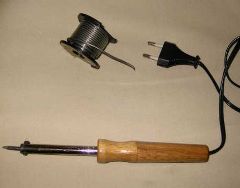 Solder is a low-melting metal alloy intended for connecting wires, leads, parts and components by soldering. Previously, solders were designated by three letters - POS (tin-lead solder), followed by a two-digit number showing the tin content in percent, for example POS-40, POS-60.
Solder is a low-melting metal alloy intended for connecting wires, leads, parts and components by soldering. Previously, solders were designated by three letters - POS (tin-lead solder), followed by a two-digit number showing the tin content in percent, for example POS-40, POS-60.
The best solder is pure tin. However, it is expensive and is used in exceptional cases. During radio installation, tin-lead solders are most often used. By the strength of soldering, they are not inferior to pure tin. Such solders are melted at a temperature of 180 - 200 ° C.
The choice of solder is made depending on such factors: from the metals or alloys being joined, from the brazing method, from the temperature limits, from the size of the parts, from the required mechanical strength, from the corrosion resistance, etc. Soldering with a melting point is used to solder thick wires ...
Who actually invented the light bulb
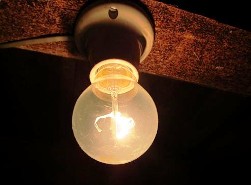 The answers to this seemingly simple question can be heard different. The Americans will undoubtedly insist that it was Edison. The British will say that this is their compatriot Svan. The French may recall the “Russian light” of the inventor Yablochkov, who began to illuminate the streets and squares of Paris in 1877. Someone will call another Russian inventor - Lodygin. There will probably be other answers. So who is right? Yes, perhaps that's all. The history of a light bulb is a whole chain of discoveries and inventions made by different people at different times.
The answers to this seemingly simple question can be heard different. The Americans will undoubtedly insist that it was Edison. The British will say that this is their compatriot Svan. The French may recall the “Russian light” of the inventor Yablochkov, who began to illuminate the streets and squares of Paris in 1877. Someone will call another Russian inventor - Lodygin. There will probably be other answers. So who is right? Yes, perhaps that's all. The history of a light bulb is a whole chain of discoveries and inventions made by different people at different times.
Before proceeding to the chronology of the invention of the light bulb, I would like to note what we mean by the term "light bulb". First of all, it is a light source, a device, a device in which the conversion of electrical energy into light occurs. But the conversion methods can be different. In the 19th century, several methods were known ...
